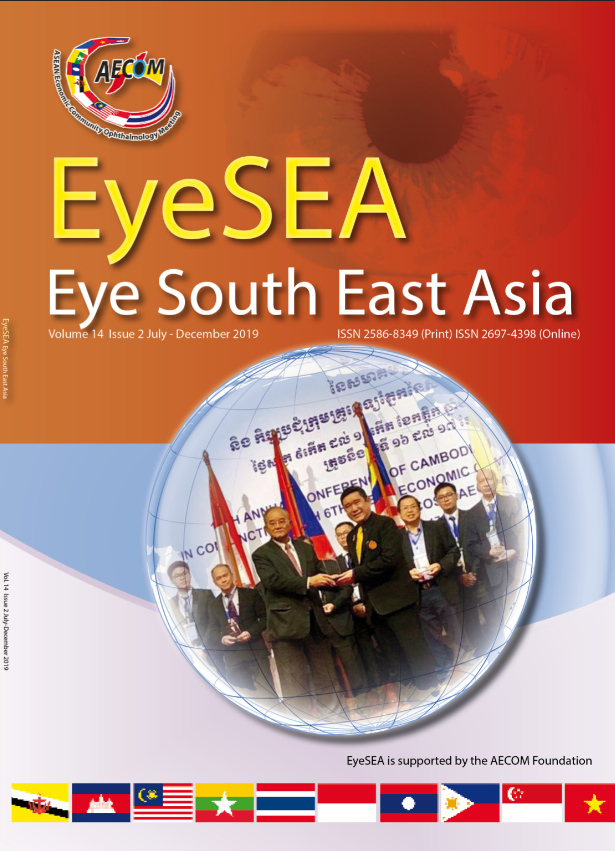Alor Setar experience: Surgical outcomes of Macular Hole surgery folding method
Main Article Content
Abstract
Abstract
Purpose: To review the surgical outcomes of macular hole surgery with internal limiting membrane (ILM) folding method in Hospital Sultanah Bahiyah (HSB), Alor Setar.
Method: A retrospective study reviewing the functional and anatomical outcomes of macular hole surgery with ILM folding method for all related cases in HSB during the period between January 2013 to December 2018.
Results: Thirty-seven patients with purely full-thickness macular hole who underwent ILM folding method surgery were included in the study, with 21 females and 16 males. Ages ranged between 51-74 years. We observed the outcomes of macular hole surgery using folding method based on visual improvement and macular hole closure at 6-weeks and 6-months post-surgery. All surgeries were performed by a single vitreo-retinal surgeon in HSB. Following macular hole surgery using folding method, 31 cases (83.8%) and thirty-three cases (89.2%) showed visual improvement by two or more lines at 6-weeks and 6-months post-surgery, respectively. Hole closure was achieved in all cases (100%) of macular hole surgery using the folding method at 6 weeks and 6 months post-surgery.
Conclusion: In conclusion, surgical outcomes of macular hole surgery using ILM folding method in Alor Setar is comparable to available literatures such as Baba et al (2017) and Matsumura et al (2016). The folding method showed superior surgical outcomes as compared to the conventional ILM peeling method in macular hole surgery. Besides techniques, macular hole surgical success is also attributed by size of macular hole and its chronicity.
Article Details
References
1. The Eye Disease Case-Control Study Group(1994) Risk factors for idiopathic macular holes. Am J Ophthalmol 118:754–761.
2. Minihan M, Goggin M, Ckleary PE. Surgical management of macular holes: results using gas tamponade alone or in combination with autologous platelet concentrate or transformin growth β2. Br J Ophthalmol 1997;81:1073-1079.
3. Gass JD. Idiopathic macular hole; its early stages and pathogenesis. Arch Ophthalmol (1988) 106:629–639.
4. Kelly NE, Wendel RT. Vitreous surgery for idiopathic macular holes: results of a pilot study. Arch Ophthalmol (1991) 109:654–659.
5. Margherio RR, Margherio AR, Williams GA, et al. Effect of perifoveal tissue dissection in the management of acute idiopathic full-thickness macular holes. Arch Ophthalmol 2000;118:495–8.
6. Lansing MB, Glaser BM, Liss H, Hanham A, Thompson JT, Sjaarda RN, et al. The effect of pars plana vitrectomy without epiretinal membrane peeling on full-thickness macular holes. Ophthalmology (1993) 100:868–872.
7. Ullrich S, Haritoglou, Gass C et al. Macular hole size as aprognostic factor in macular hole surgery. Br J Ophthalmol 2002;86:390-393.
8. Freeman WR, Azen SP, Kim JW, et al. Bailey I for the vitrectomy for treatment of macular hole study group. Vitrectomy for the treatment of full-thickness stage 3 or 4 macular holes. Arch Ophthalmol 1997;115:11–21.
9. Ryan EH, Gilbert HD. Results of surgical treatment of recent-onset full thickness macular holes. Arch Ophthalmol (1994) 112:1545–1553.
10. Thompson JT, Glaser BM, Sjaarda RN, Murphy RP, Hanham A. (1994) Effects of intraocular bubble duration in the treatment of macular holes by vitrectomy and transforming growth factor beta 2. Ophthalmology 101:1195–1200.


